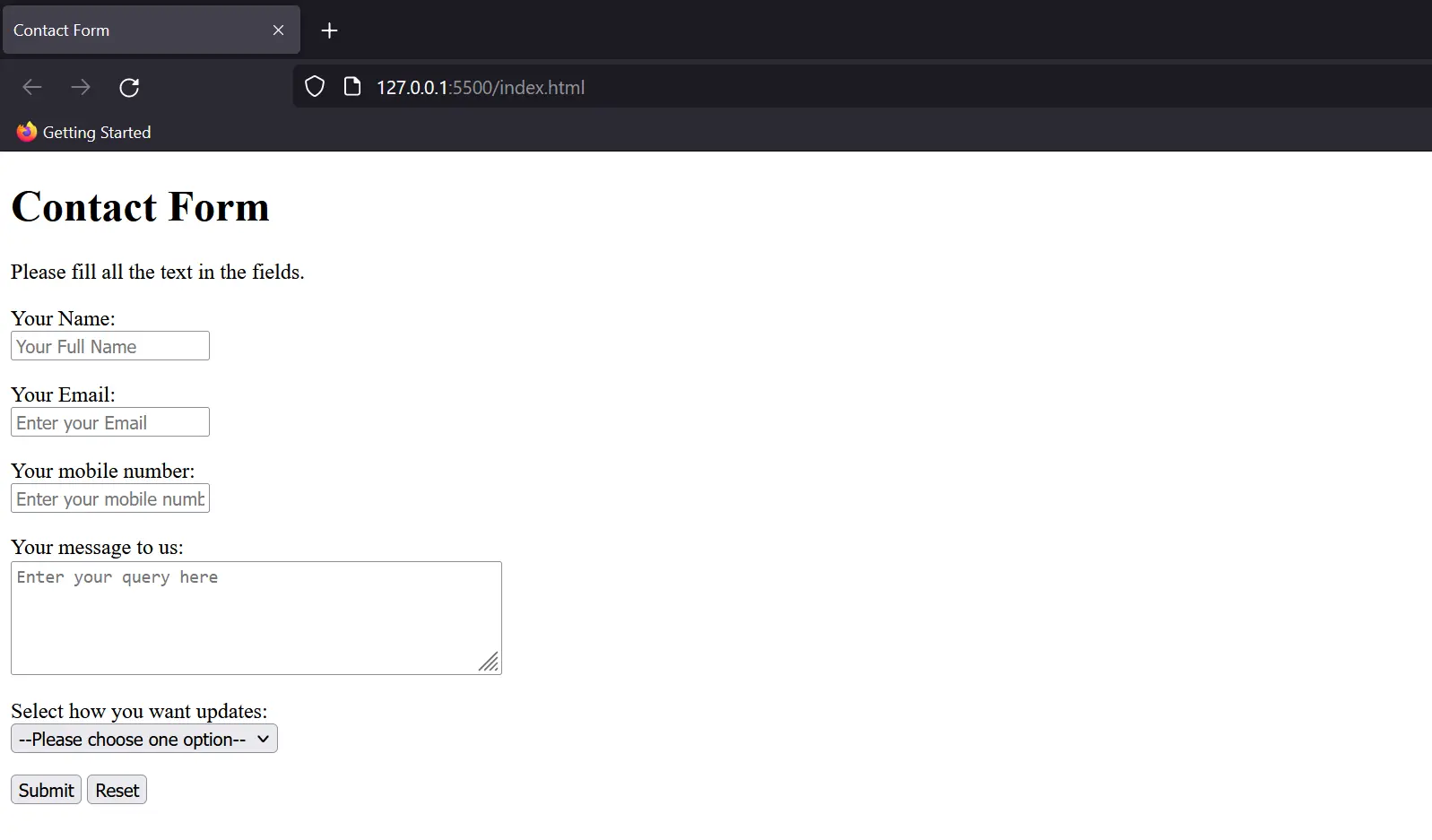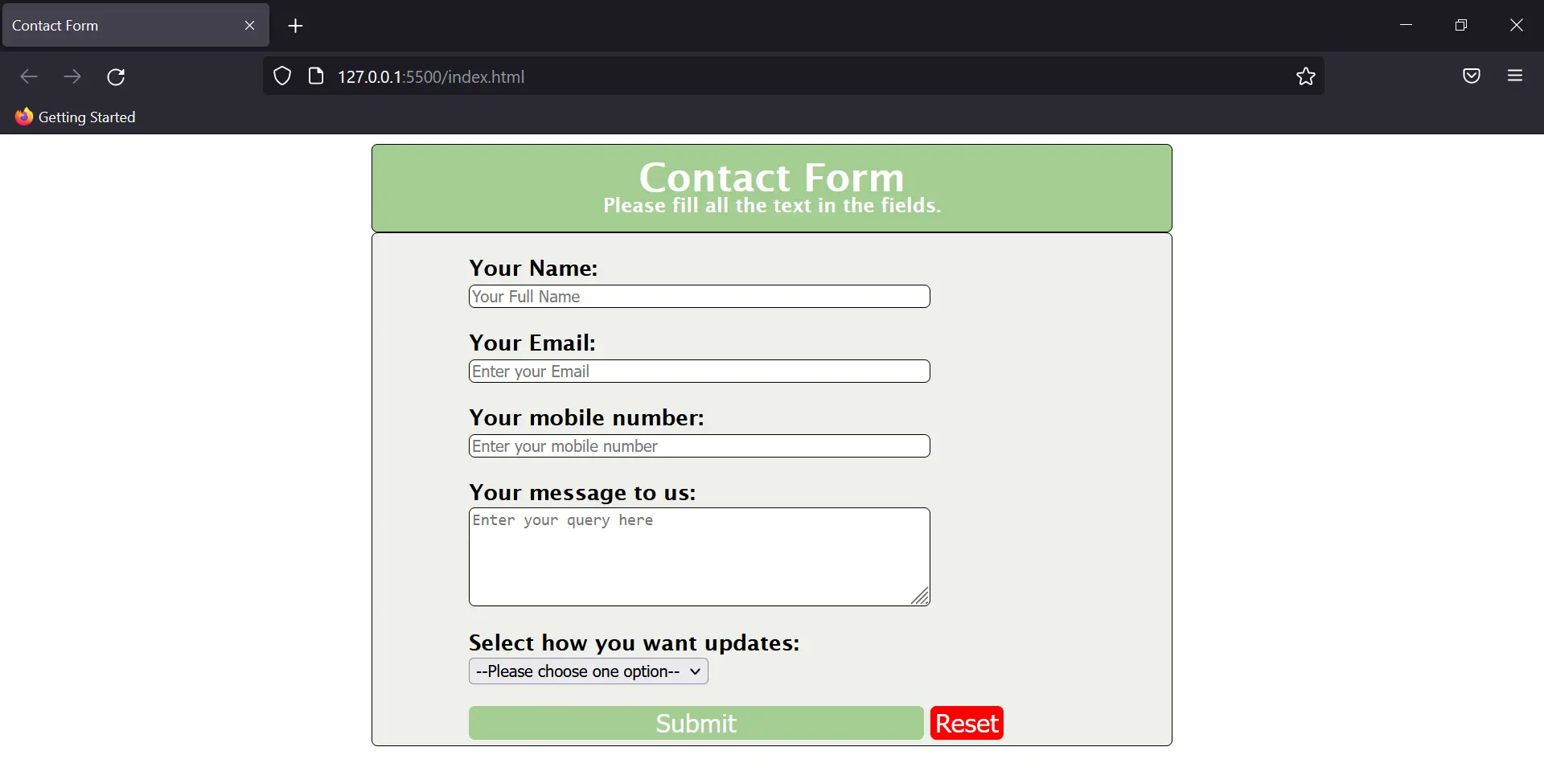Forms
Forms are one of the most important parts of a website. They allow users to interact with your site — whether it’s signing up, logging in, or submitting queries. However, raw HTML forms often look plain and unappealing.
With CSS, you can completely transform a simple form into something attractive, user-friendly, and responsive.
Basic HTML Form (Without CSS)
<!DOCTYPE html>
<html lang="en">
<head>
<title>Contact Form</title>
<link rel="stylesheet" href="style.css">
</head>
<body>
<div>
<h1>Contact Form</h1>
<p id="Subheading">Please fill all the text in the fields.</p>
</div>
<form action="">
<p class="name">
Your Name:<br>
<input type="text" placeholder="Your Full Name">
</p>
<p class="email"> Your Email:<br>
<input type="email" name="email" id="" placeholder="Enter your Email">
</p>
<p class="number">
Your mobile number:<br>
<input type="text" placeholder="Enter your mobile number">
</p>
<p class="message">
Your message to us:<br>
<textarea name="message" id="" cols="50" rows="5" placeholder="Enter your query here"></textarea>
</p>
<p>Select how you want updates:<br>
<select name="Select" id="">
<option value="Choose">--Please choose one option--</option>
<option value="op1">Message</option>
<option value="op2">Call</option>
<option value="op3">Email</option>
</select>
</p>
<input type="submit" value="Submit"> <input type="reset" value="Reset">
</form>
</body>
</html>Output (Without CSS)

As you can see, it looks quite raw and not very user-friendly. Let’s improve it using CSS.
Styling the Form with CSS
Now let’s add a separate stylesheet (style.css) and apply styles to make the form modern and professional.
body {
padding: 0px 300px;
font-family: 'Lucida Sans', 'Lucida Sans Regular', 'Lucida Grande', 'Lucida Sans Unicode', Geneva, Verdana, sans-serif;
text-decoration: solid;
font-weight: 900;
}
div {
padding: 5px 5px;
background-color: rgb(164, 206, 147);
width: auto;
color: white;
line-height: 10%;
text-align: center;
border-radius: 5px;
border: 1px solid black;
}
form {
background-color: rgb(238, 239, 235);
border-radius: 5px;
border: 1px solid black;
padding: 0px 80px 5px;
font-size: large;
}
input[type="text"],
input[type="email"],
textarea {
width: 75%;
border: 1px solid black;
border-radius: 5px;
background-color: white;
}
input[type="submit"] {
background-color: rgb(164, 206, 147);
font-size: larger;
color: white;
border-radius: 5px;
border: none;
cursor: pointer;
width: 75%;
}
input[type="reset"] {
background-color: red;
font-size: larger;
color: white;
border-radius: 5px;
cursor: pointer;
border: none;
}
input[type="submit"]:hover {
background-color: rgb(0, 176, 76);
}
input[type="reset"]:hover {
background-color: rgb(191, 0, 0);
}This stylesheet covers almost all the rules we’ve seen so far.
Output (With CSS Applied)

Now the form looks clean, modern, and user-friendly. The hover effects make the buttons more interactive, and the overall design feels professional.
Key Takeaways
- Forms in plain HTML look unstyled and are not user-friendly.
- CSS lets you control everything — layout, background colors, spacing, borders, and hover states.
- You can further enhance this with:
- Responsive design using @media queries.
- Placeholder styling using ::placeholder.
- Better focus indicators with :focus.